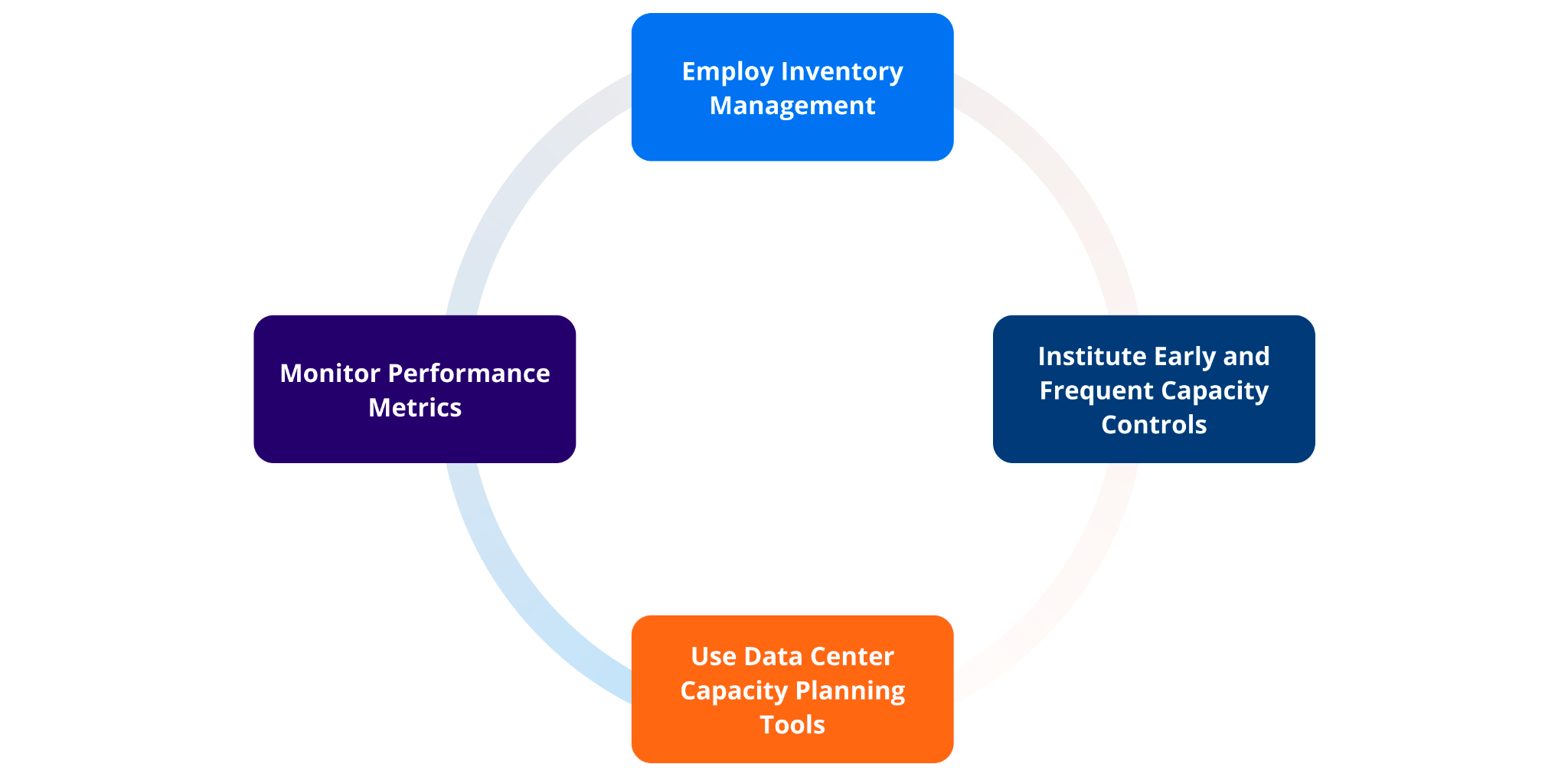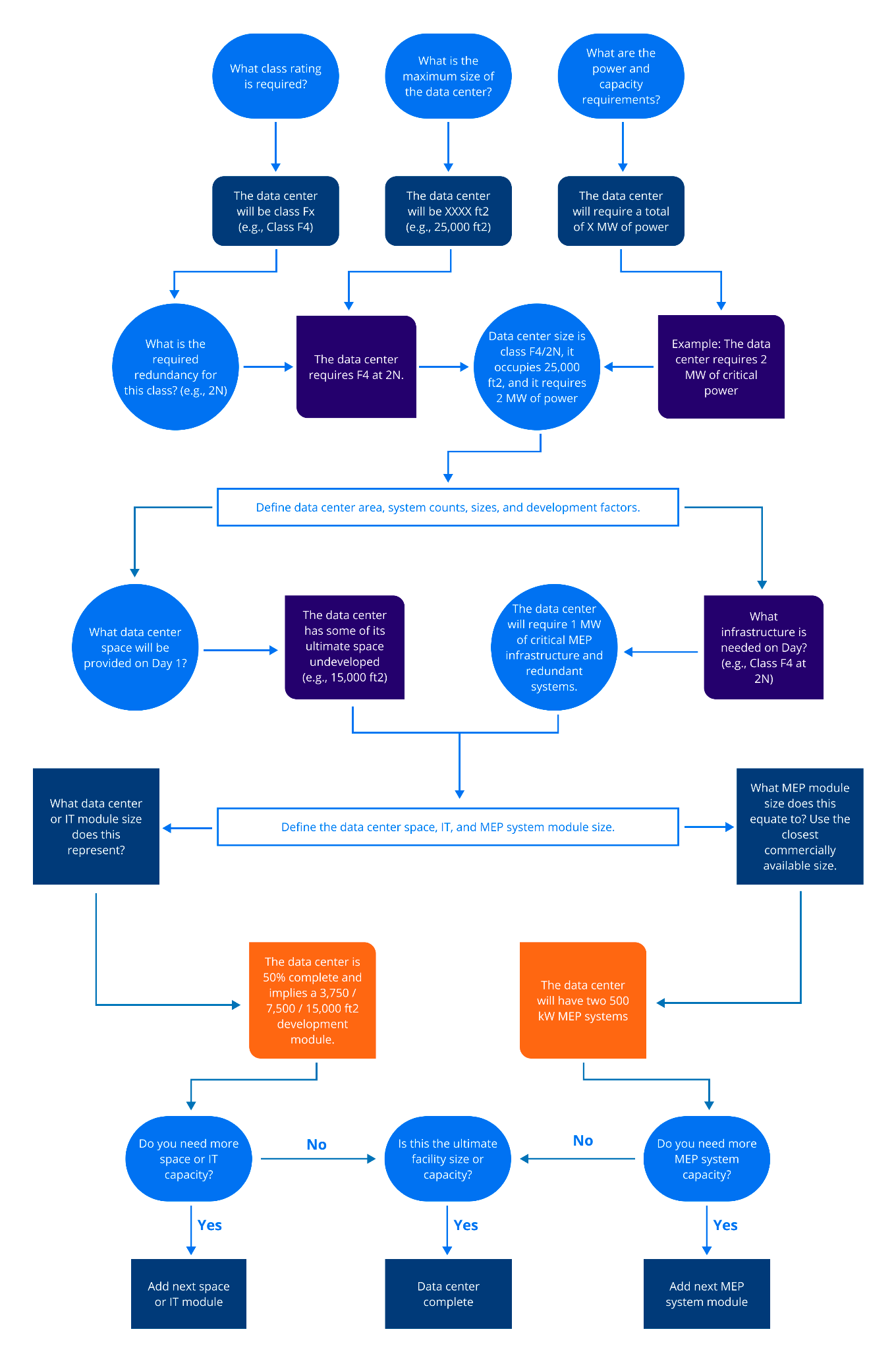Understanding Data Center Capacity Planning
Data center capacity planning comprises an IT organization’s strategy to ensure that its computing resources, footprint, power load, and cooling capacity can satisfy the workload demands of its users, customers, and clients. This process helps with not only ensuring the efficient use of the mechanical, electrical, and physical infrastructure but also detecting system failures that may occur. It increases sustainability and allows data centers to provide quality service to their customers.
Data center capacity planning is an ongoing process because critical infrastructure planning and assessment of critical services are constantly increasing in importance.
Summary of key concepts
| Concept | Explanation |
|---|---|
| Data center capacity planning disciplines | The key disciplines include power, cooling, facilities, networks, data storage, and sustainability. |
| Determining the required capacity | This process involves assessing capacity at the rack, row, and room levels. |
| Use of DCIM software | DCIM software can be effective in helping with capacity planning and inventory management. |
| Data center capacity best practices | Essential best practices for capacity planning include asset management, using performance metrics, employing early and frequent capacity controls, and using data center capacity planning tools. |
| Recommendations | Capacity planning recommendations based on TIA/BICSI/UPTIME standards can be broken into three categories: facilities, electrical, and cooling. |
Why is data center capacity planning important?
Data centers are built and run to have the same high level of availability as the facility that houses them. This requires careful design and operation of all subsystems to make sure everything works together seamlessly.
The capacity of a data center is determined by the needs of the IT equipment being hosted. The power and cooling systems necessary to support the equipment are taken into consideration, including the necessary measurements and detail levels to meet the critical needs of the IT systems.
The significance of data center capacity planning has grown with the increasing attention paid to environmental considerations. This planning process involves evaluating factors such as electrical power capacity, resource requirements, and cooling capacity to achieve efficient utilization of energy and water, thereby minimizing the carbon footprint of the facility. The sustainability of data centers can be evaluated through various metrics, including the ratio of green energy sources to total energy consumption, the calculation of carbon footprint, and water usage analysis. The implementation of efficient capacity planning plays a crucial role in promoting environmentally friendly practices in data centers and, as a result, it has become a high priority for many organizations.
In the initial investment and projection phase, it is crucial to incorporate the planning of key components as part of the growth strategy. Insufficient or excessive planning of these elements can lead to substantial losses in terms of both materials and labor.
Oversizing the data center infrastructure can mean inefficient use of the initial investment. All equipment, including cabinets, power systems, and cooling systems will be commissioned above capacity, leading to excessive cost. Conversely, undersizing at the planning stage means an inability to adequately meet the demands of customers.
Data center capacity planning disciplines
There are six interconnected capacity planning disciplines in data center capacity planning:
- Power: Determining the current/power-carrying capacity of cable conductors and their switching characteristics and upgradeability
- Cooling: Determining the capacity of chillers, HVAC systems, or computer room air conditioning (CRAC) systems as well as their redundancy and upgradeability requirements
- Facilities: Calculating the necessary space, determining the occupancy rate of the facility, and figuring out what new space will be required for future needs
- Networks: Planning internet and wireless connection redundancy, connection speeds, and physical connections
- Data storage: Determining the storage capacity of the system and necessary redundancy and backups
- Sustainability: Evaluating energy efficiency and considering environmentally responsible solutions for data center operations and infrastructure.
Determining the required capacity
Data center capacity planning involves evaluating current and future computing equipment needs, power and cooling, and space requirements to ensure alignment with IT needs and minimize the risk of failure and downtime. The capacity is evaluated at three levels: rack, row, and room.
Rack-level capacity determination
Rack-level capacity planning in data centers involves determining the necessary space, power, and cooling resources to support IT equipment within a specific rack. The process involves evaluating the equipment’s power and cooling needs, determining space for cable management and airflow, and checking that the rack can support the weight of the equipment. It also involves figuring out the number of devices that can fit in the rack and their power requirements as well as ensuring sufficient power and cooling to prevent equipment failure and downtime. Proper planning ensures that the data center has the capacity to support IT equipment and minimizes issues.
Let’s look at an example. Suppose that a company is planning to add a new server to its data center with the following specifications:
- Power requirements: 2 kW
- Cooling requirements: 4,000 BTU/hr
- Rack space: 2 rack units (2U)
The data center team would begin by assessing the available space in the data center to determine if there is an empty rack that can accommodate the new server. They would also check the power and cooling resources available in the data center to ensure that there is enough capacity to support it.
Next, the team would measure the power and cooling requirements of the server and determine how much power and cooling capacity is needed to support the new server’s needs of 2 kW of power and 4,000 BTU/hr of cooling. If the data center has enough capacity to meet these needs, the team can proceed with installing the server in the rack. If not, they may need to find an alternative location for the server; if this is not possible, it may be necessary to consider upgrading the power and cooling infrastructure.
Finally, the team would check the cable management and airflow in the rack to ensure that the new server can be properly installed without blocking airflow or causing cable management issues. They would also check the weight capacity of the rack to ensure that it can support the weight of the new server.
Row-level capacity determination
Row-level capacity planning for data centers involves identifying and forecasting the power, cooling, and space requirements for each row of server racks in the data center. This approach allows for more granular and accurate capacity planning than only looking at the data center as a whole because it considers the equipment’s specific power and cooling needs in each row. It also allows for better energy efficiency and cost optimization by identifying areas where cooling or power is being wasted.
The process typically includes the following:
- Identifying the current and future power and cooling requirements for each row of server racks based on the type and number of devices in the racks
- Analyzing the power and cooling infrastructure of the data center to determine if it is sufficient to meet the requirements of each row
- Developing a plan to address any capacity shortfalls, which may involve upgrading the power and cooling infrastructure, relocating equipment, or adding additional rows of server racks
- Continuously monitoring the power and cooling usage of each row and adjusting the plan as necessary
The organization of the rows is a crucial aspect of capacity planning in data centers. Different rows can have different types of equipment, each with different power and cooling requirements. To ensure the efficient utilization of resources and avoid overloading the power and cooling infrastructure, the team must decide on an optimal arrangement of rows based on the specific requirements of each type of equipment. This could involve grouping together similar types of equipment in the same row or separating high-power-consumption devices from low-power-consumption devices to prevent overloading of the infrastructure.
Room-level capacity determination
Room-level capacity planning considers the entire room in a data center, including all components, like server racks, power, cooling, and network infrastructure. It evaluates the total capacity needed and ensures that all equipment is supported without overloading any systems. It’s a more comprehensive view compared to rack- or row-level planning.
Data center capacity planning methodology
Example data center capacity calculation flowchart
The accompanying diagram presents a capacity planning flowchart for data centers. It asks a series of interrelated questions to determine the size, class, and power requirements of a proposed data center. These questions encompass the ultimate size of the data center, its power capacity requirements, the redundancy for the specified class, the mechanical, electrical, and plumbing (MEP) system capacity of the data center, and whether there is a need for additional space or IT capacity. By asking a series of interrelated questions and providing suggestions for further development, it serves as a useful tool for data center capacity planning.
Based on the responses provided, the diagram calculates the area of the data center, the sizes of the IT and MEP system modules, and the portions that have been developed. The diagram also recommends adding more space or IT modules if more space or IT capacity is required, and adding a MEP system module if more MEP system capacity is necessary.
Let’s take a look at an example of calculating the UPS power capacity of a room. In a data center, there are 40 rack cabinets. Each row has 10 cabinets, so there are four rows. Each cabinet is designed at an uptime Tier 3 or Tier 4 level and has an electrical power requirement of 5 kW. Each cabinet is powered by A and B backup UPS lines, and each energy line can have a maximum occupancy rate of 90%. (Tier 3 is a standard level of service that provides 99.982% uptime, while Tier 4 is the highest level of service, providing 99.995% uptime with multiple redundant components and no single point of failure.)
Based on the known information, we can calculate the total energy requirement for the data center by multiplying the number of cabinets (40) by the power per cabinet (5 kW), which results in a total of 200 kW. If we consider that each cabinet is powered by A and B backup UPS lines, both lines should have a capacity of 200 kW. As the maximum occupancy rate for both lines is 90%, the capacity for each line should be 200 kW / 0.9 = 222.22 kW.
As a result of the data center being designed at the Tier 3 or Tier 4 level, backup energy systems will be able to provide enough power when needed. Therefore, it can be stated that the capacity is sufficient to meet the energy needs of the data center.
The following is a summary of the steps involved in the methodology:
- Calculate the current capacity: Determine the capacity of the system and the managed devices located within the critical area being considered.
- Calculate the current loading: Calculate the instantaneous load within the critical area for the managed attribute.
- Determine the design conditions: A single point of failure is a potential failure that will stop the entire system from working if one component fails. Whether caused by hardware, software, or human error, single points of failure are undesirable in any system with high availability or reliability goals.
- Futureproof: It’s essential to always keep future needs in mind when doing any planning. This necessitates an extra investment up front but pays dividends down the road. Remember that the data center is a “living thing” that starts at the project planning stage and continues until the end of its usable life.
DCIM software
“You can’t manage what you can’t measure.”
— Peter Drucker
Data center infrastructure management (DCIM) software is a class of software that enables data center operators to run their facilities efficiently and improve infrastructure planning and design. It is often used in place of legacy tools such as Excel, Visio, and native databases.
How DCIM software works
DCIM software is a solution that helps organizations collect and manage information about their data center assets, infrastructure, and environments. It works by collecting data from various sources within the data center, such as physical assets, power and cooling systems, and network and security systems. The software then uses this data to provide real-time visibility about physical and logical layouts and control over data center operations.
Overall benefits of DCIM software
DCIM software can bridge information among enterprise domains (data center operations, facilities, and IT) to maximize data center utilization. DCIM software interrogates equipment, collects data, monitors trends, and issues reports, continuously monitoring the infrastructure of critical data center facilities. With built-in alerts, it prevents possible malfunctions from affecting users and services.
Using DCIM in a new or existing data center automates most measurement tasks and provides early warning of failures, errors, and potential failures. It improves uptime with the intelligent lifetime monitoring of many data center components.
Power and cooling strategy
DCIM tools help organizations manage the power and cooling strategies for their data centers. These tools provide visibility into the real-time power consumption of data center equipment, allowing for more efficient use of energy and cooling resources. The power and cooling strategy of a data center can impact its overall efficiency, reliability, and sustainability, and DCIM tools help organizations optimize these resources to ensure that the data center runs smoothly and effectively. Some DCIM tools also offer features such as capacity planning, energy reporting and analysis, and predictive modeling to help organizations optimize their data center infrastructures.
Data center capacity reporting
DCIM software helps organizations manage data center infrastructure by collecting data on the capacity and utilization of physical resources such as power, cooling, space, and network connectivity. This information is presented in the form of capacity reports, which provide a comprehensive view of the current and future capacity needs of the data center. The use of DCIM for capacity reporting offers several benefits over manual methods, including more accurate and timely data, consistent reporting, improved visibility, and time savings.
Asset management
DCIM software allows you to manage the inventory in your data center rooms easily by providing a centralized platform to track and manage all assets, including servers, firewalls, UPSes, CRAC systems, and rack PDU equipment. The software allows you to keep track of each asset’s location, ownership, utilization, and maintenance history, so you can optimize the use of your resources and avoid equipment downtime.
Additionally, the software can provide alerts and notifications for critical events, such as equipment failures or capacity issues, helping you to respond quickly and effectively.
Integration with building management systems
A building management system (BMS) is a computer-based control system installed in a building that controls and monitors the mechanical, electrical, and other systems, such as heating, ventilation, air conditioning, lighting, security, and fire protection. The goal of BMS is to provide a comfortable, safe, and energy-efficient environment for building occupants and to manage and maintain building assets and infrastructure.
DCIM and BMS software have similar features, such as power usage efficiency (PUE) calculations, power consumption monitoring, heat map monitoring, alarm and error notifications, and preventive maintenance monitoring. However, the integration of these two systems offers a more efficient platform than using either alone. DCIM excels at providing detailed data analysis, while BMS software excels at communicating data and converting it into action. By integrating these two software capabilities, results can be transformed into concrete actions. The systems can also be automated by setting threshold values and warning notifications.
The integration of DCIM and BMS software also enables the automation of data management processes. Threshold values and warning notifications can be set, allowing the systems to automatically alert relevant parties when certain conditions are met. This reduces the need for manual intervention, freeing up time and resources for other tasks. The automation of data management processes also ensures that decisions are based on accurate and up-to-date information, leading to better outcomes.
BMS and DCIM setups can be connected through APIs to allow the exchange of data between the two systems in a standardized format. Additionally, both systems should use common data structures and have a properly configured data flow to ensure that data is collected, processed, and utilized accurately. To further facilitate this, both systems should also use shared data storage systems to ensure easy access and proper storage of the data.
Overall data center capacity best practices
To ensure success in data center capacity planning, follow best practices in four key areas as described below.

Employ inventory management
The first step is keeping track of all data center assets and resources, including hardware, software, and network components. This helps ensure that the data center management team has an accurate understanding of the center’s current capacity and can plan for future growth.
Institute early and frequent capacity controls
Implement regular monitoring and control of data center capacity to identify and resolve any potential bottlenecks before they become critical issues. This helps ensure that the data center can continue to operate at peak efficiency.
Use data center capacity planning tools
Make use of various tools and technologies designed to help manage data center capacity. This may include predictive analytics tools, capacity planning software, and other IT management tools.
Monitor performance metrics
Finally, be sure to regularly monitor performance metrics to assess the efficiency and effectiveness of data center capacity management efforts. This helps ensure that data center capacity is aligned with business objectives and that improvements can be made over time.
Specific recommendations for data center capacity planning
Data centers encompass three key areas: facilities, electrical, and mechanical. Here are some recommendations when calculating capacity in each of these disciplines.
It is important to keep in mind that the exact requirements for each data center capacity plan will depend on the individual needs and constraints of the organization.
Facilities
- The data center should have sufficient space for the planned equipment as well as room for future expansion. This includes adequate aisle space, effective cable management systems, and adequate consideration of equipment height and layout.
- Consider the height of the equipment, as well as the space required for cable management, to ensure that the data center is optimized for efficient use of space.
- Implement a robust cable management system that is designed to organize cables, reduce clutter, and improve airflow in the data center.
- Consider using raised flooring or overhead cable trays to manage cables and improve airflow. Also consider using cable ladders or conduit to route and protect cables. Label all cables clearly to support efficient maintenance and troubleshooting.
- Identify potential growth rates not only within business units but also across platforms, as these affect capacity and space plans.
Power
- To ensure reliable operation and avoid downtime, it is important to have backup power sources, such as uninterruptible power supplies (UPSes) and generators.
- It is crucial to consider both current and future power demand and the power density of equipment that will be installed when planning for power capacity.
- Adopting energy-efficient power distribution and management systems can improve power utilization, reduce costs, and have a positive impact on the environment.
Cooling
- The cooling system should be designed to handle the expected heat load generated by the data center equipment, taking into account factors such as room temperature, humidity, and airflow patterns.
- Energy-efficient cooling solutions, such as air-side economizers or liquid cooling systems, can help lower energy consumption and minimize the environmental impact of the data center.
- Regular monitoring and maintenance of the cooling system are necessary to prevent equipment failures and maintain optimal performance.
Conclusion
The specifications of data center devices and the infrastructure that supports them are changing very rapidly, making data center capacity planning more important than ever. Take into account the following when doing data center capacity planning:
- Current capacity status and resource usage
- Future plans and capacity needs
- End-of-life and obsolescence timeframes for data center infrastructure equipment
- The design and implementation of newer resources as they become available
- Investing in DCIM software to support capacity planning processes





